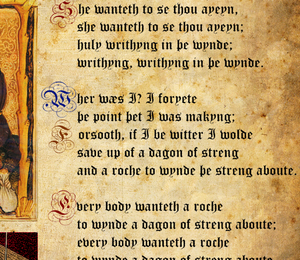User:MacMania/Rock to wind a piece of string around
The rock to wind a piece of string around was the most common device for winding string around in the 1300s. It was typically bundled with a piece of string, and worked by having the user wind this piece of string around the rock.
The rock to wind a piece of string around was also the precursor to the spool, as well as—according to the latest speculation and rumours—the big prosthetic forehead on a real head.
Origins[edit | edit source]
The origins of the rock to wind a piece of string around are unclear; neither its inventors nor their original name for the device are known. However, the device was popular enough that the first recorded mention of the rock to wind a piece of string around is found in a fragment of Geoffrey Chaucer's The Canterbury Tales, in the story titled "The Possibly-Giant's Tale." The original fragment, in Middle English is as follows:
- "She wanteth to se thou ayeyn,
she wanteth to se thou ayeyn;
huly writhyng in þe wynde;
writhyng, writhyng in þe wynde."
Wher wæs I? I foryete
þe point þet I was makyng;
Forsooth, if I be witter I wolde
save up of a dagon of streng
and a roche to wynde þe streng aboute.
Literally translated, the bold text refers to "a rock to wind the string about." However, the very next line of the story mentions that "Every body wanteth a roche / to wynde a dagon of streng aboute," revealing the actual name of the product, "a rock to wind a bit of string about."
Takeover by Raymond Guild of Stonecutters[edit | edit source]
Although Chaucer was first to mention the rock to wind a piece of string around, most of the innovation took place across the pond, in continental Europe. Later records establish that the manufacture of the device was eventually taken over by the Raymond Guild of Stonecutters. The guild was founded in 1375, based in Raymond, France, in a building dubbed the "Couchette" or "Crib". It was led by William Egress, who had been banished from a monastery near Cambridge, England, for peddling rocks to wind fibres of cotton around.
In 1381, the Raymond Guild was commissioned by the House of Savoy (sometimes called Big Blue because of the House's colour) to manufacture rocks to wind pieces of string around. To satisfy this order, the Raymond Guild copied from the Monterrei Guild, based in Galicia, Spain. Later the Monterrei Guild would wage a small war against the House of Savoy and lose, and eventually its members would integrate into the Middlesex County Guild.
Rivalry with Copertino Guild of Stonecutters[edit | edit source]
In 1384, the Copertino Guild of Stonecutters, based in "la Casa Giocattolo" or "the Playhouse" in Copertino, Italy, came into the public eye. The guild, which had recently been mired in scandal due to their use of wood as a raw material, attempted an entry into the market with their "DelDuca" rock to wind a piece of string around. The most significant "innovation" of the DelDuca rock was its interface, which incorporated a mouse that would automatically scurry around and wind the string attached to its tail around the rock. Although it was in fact stolen from research done at the Monastery of Santa Clara in Portugal, everyone was too busy wanting a rock to wind a piece of string around to care.
One year later, the Raymond Guild revealed its own new interface, very similar to that of the Copertino Guild's interface. Although at first the Copertino Guild let the similarities pass, by 1388 the similarities were far too uncanny. To the Copertino Guild, it was clear that the Raymond Guild had stolen the rough look and feel of their DelDuca rocks. A war was brewing, waiting to happen.
Copertino Wars (1388-1392)[edit | edit source]
The Copertino Wars started in 1388, when mercenaries employed by the Copertino Guild charged into Raymond and attempted to throw the Crib's doors wide and assassinate William Egress, the leader of the Raymond Guild. Copertinian agents formally voiced the complaint that the Raymond Guild had copied off of their own guild. This declaration, of course, meant war to both sides.
Egress, now utterly furious, sent his own agents to Copertino to hatch a covert operation that would bring the Copertino Guild to its knees, specifically by burning down their headquarters, the "Playhouse". As a Raymond bard once sang before being fatally smothered by rotten tomatoes,
| “ | Quelqu'un à cette ville essaie de brûler la Maisonette; ils veulent arrêter ceux qui veulent une pierre pour enrouler un bout de ficelle. |
” |
Eventually, the matter was decided in a peace treaty in Constantinople, in one of the Byzantine Empire's more significant acts. Copertino's agents would back down from its claims if the Raymond Guild would agree to maintain development of several buttons that could be installed onto the DelDuca rocks to wind a piece of string around, which provided valuable additional features such as the ability to tie the string onto the button and thereby make the string more secure.
Aftermath of the Battle[edit | edit source]
invention of bobbin--more portable device with most functionalities retained


